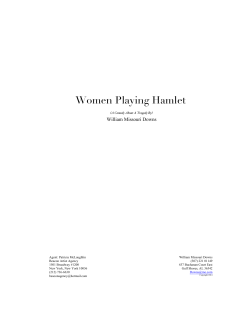
Social and Economic Regulations
Social and Economic Regulations Group #5: Ljaz Akram Cynthia Aponte Aisha Mamane Jessica Okolotkiewicz Richard Torchon Prof. Kone: Microeconomics What is Social Regulation? Regulation consists of rules identifying permissible and impermissible activity on the part of individuals, firms, or government agencies. Social Regulations are aimed at restricting behaviors that directly threaten public health, safety welfare or well being. Group #5: Aisha Mamane Energy and Environment -EPA (Environmental Protection Agency) Health and Safety -OSHA ( Occupational Safety and Health Administration) Group #5: Aisha Mamane Product & Labor Market Product Market CPSC (Consumer Product Safety Commission) - Recalls - Labels contents Labor Market EEOC (Equal Employment Opportunity Commission) - Investigate complaints Group #5: Aisha Mamane What is Economic Regulation? The prescribing of prices and output levels for entire industries. Natural Monopolies Railways Telecommunications Utilities Mail Delivery Group #5: Jessica Okolotkiewicz Natural Monopolies “A natural monopoly exists when economies of scale make it efficient for a single firm to supply the entire market.” LEGEND LRATC = Long-run average total cost ATC = Average total cost Group #5: Jessica Okolotkiewicz Anti-Trust Laws Government policies and programs designed to control the growth of monopoly and enhance competition. Group #5: Jessica Okolotkiewicz The Fair Rate of Return Regulation is used to make price and supply much like what a perfectly competitive industry would provide. – At Pm too little output and too much profit for a firm is yielded. – At Pr the company produces Qr but is subject to make a loss because the demand lies below the average total cost. – Regulation provides a cost of Pf which is set at a zero economic profit, where demand and average total cost intersect. LEGEND ATC = Long-run average total cost D = Demand MC = Long-run marginal cost MR = Marginal revenue Group #5: Jessica Okolotkiewicz Problems with Regulation Price is set at a percentage of average cost. Creates Negative Incentives Increase costs Run inefficiently Acquire excess capacity Money is wasted in order to increase rates to increase profits. Group #5: Jessica Okolotkiewicz What is Deregulation? The government removes, reduces, or simplifies restrictions on businesses. Simpler regulations lead to more competition, which increases productivity. Group #5: Cynthia Aponte Airline Deregulation Act of 1978 The main purpose of the act was to remove government control from commercial aviation and expose the passenger airline industry to market forces. Group #5: Cynthia Aponte Benefits of Deregulation The airline industry expanded and they were able to attract travelers with discounts, more flights, and lower rates. Trucking companies were able to set their own rates, routes, and carry more freight. Group #5: Cynthia Aponte Effects of Deregulated Industries Many airlines and trucking firms became bankrupt due to the increased competition. Group #5: Cynthia Aponte Airlines Affected by the Deregulation Act of 1978 Eastern Airlines Pan Am TWA Continental Group #5: Cynthia Aponte Privatization Occurs when a government-run business is transferred to a privately owned business. Many private firms are providing garbage services, water services, and road building maintenance. These are contracted out (privatized) by the city or state. Group #5: Cynthia Aponte Regulation and Deregulation in other countries Group #5: Richard Torchon Nationalization Definition: Government takes over and operates an industry. It was preferred rather than regulation as a solution to natural monopoly in many regions in the world. Issue: Compensation from the government to the private company being bought out. Group #5: Richard Torchon Privatization Definition: transfer of ownership from the public sector to the private sector. Three types: 1. 2. 3. Wholesale privatization – entire publicly owned firm is transferred to private ownership. Contracting out – specific aspect of a government operation is carried out by private firm. Auctioning – the rights to operate a government enterprise go to the highest private-sector bidder Group #5: Richard Torchon Privatization (cont.) Since 1980, more than 80 countries have launched efforts to privatize their stateowned-enterprises (SOE). since 1980, more than 7000 SOEs have been privatized worldwide. Group #5: Richard Torchon Privatization (cont.) Issue: Pro-privatization believes that private markets actors can be more efficient due to free market competition. Anti-privatization argue that that governments ensure the efficiency of their enterprises in order to gain potential voters. Group #5: Richard Torchon International Regulations GATT and the WTO Group #5: Ijaz Akram The General Agreement on Tariff and Trade ( GATT) The World Trade Organization (WTO) Group #5: Ijaz Akram The GATT The first global trade agreement called GATT. In April 1947, delegates from the United states, Asia, Europe and Latin America traveled to Geneva, Switzerland. Aware of the effects of trade restrictions on economics health that had been experienced during the Great Depression. Group #5: Ijaz Akram The WTO Location: Geneva, Switzerland Established: 1 January 1995 Created by: Uruguay Round negotiations (1986–94) Membership: 150 countries (since 11 January 2007) Budget: 175 million Swiss francs for 2006 Secretariat staff: 635 Head: Pascal Lamy (Director-General) Group #5: Ijaz Akram Functions Administering WTO trade agreements Forum for trade negotiations Handling trade disputes http://www.wto.org/ Group #5: Ijaz Akram
© Copyright 2025














